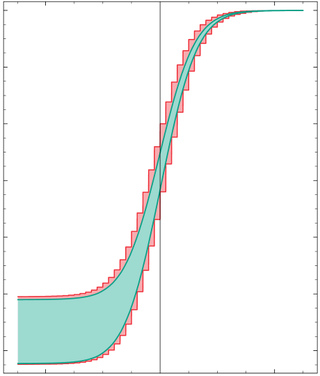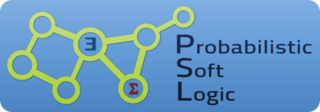Example rule
are expressed in CLP(BNR) as:
?-{X>=0,Y>=0,tan(X)==Y,X**2+Y**2==5}.and a typical implementation's response would be:
X = _58::real(1.0966681287054703,1.0966681287054718),
Y = _106::real(1.9486710896099515,1.9486710896099542).
Yes
BNR Prolog, also known as CLP(BNR) is a declarative constraint logic programming language based on relational interval arithmetic developed at Bell-Northern Research in the 1980s and 1990s. Embedding relational interval arithmetic in a logic programming language differs from other constraint logic programming (CLP) systems like CLP(R) or Prolog-III in that it does not perform any symbolic processing. BNR Prolog was the first such implementation of interval arithmetic in a logic programming language. [1] Since the constraint propagation is performed on real interval values, it is possible to express and partially solve non-linear equations. [2]
are expressed in CLP(BNR) as:
?-{X>=0,Y>=0,tan(X)==Y,X**2+Y**2==5}.and a typical implementation's response would be:
X = _58::real(1.0966681287054703,1.0966681287054718),
Y = _106::real(1.9486710896099515,1.9486710896099542).
Yes
Logic programming is a programming, database and knowledge-representation and reasoning paradigm which is based on formal logic. A program, database or knowledge base in a logic programming language is a set of sentences in logical form, expressing facts and rules about some problem domain. Major logic programming language families include Prolog, Answer Set Programming (ASP) and Datalog. In all of these languages, rules are written in the form of clauses:
Prolog is a logic programming language associated with artificial intelligence and computational linguistics.
The relational model (RM) is an approach to managing data using a structure and language consistent with first-order predicate logic, first described in 1969 by English computer scientist Edgar F. Codd, where all data is represented in terms of tuples, grouped into relations. A database organized in terms of the relational model is a relational database.
In logic and computer science, unification is an algorithmic process of solving equations between symbolic expressions. For example, using x,y,z as variables, the singleton equation set { cons(x,cons(x,nil)) = cons(2,y) } is a syntactic first-order unification problem that has the substitution { x ↦ 2, y ↦ cons(2,nil) } as its only solution.
In mathematics, an inequation is a statement that an inequality holds between two values. It is usually written in the form of a pair of expressions denoting the values in question, with a relational sign between them indicating the specific inequality relation. Some examples of inequations are:
Constraint programming (CP) is a paradigm for solving combinatorial problems that draws on a wide range of techniques from artificial intelligence, computer science, and operations research. In constraint programming, users declaratively state the constraints on the feasible solutions for a set of decision variables. Constraints differ from the common primitives of imperative programming languages in that they do not specify a step or sequence of steps to execute, but rather the properties of a solution to be found. In addition to constraints, users also need to specify a method to solve these constraints. This typically draws upon standard methods like chronological backtracking and constraint propagation, but may use customized code like a problem-specific branching heuristic.
In computer science, declarative programming is a programming paradigm—a style of building the structure and elements of computer programs—that expresses the logic of a computation without describing its control flow.
Curry is an experimental functional logic programming language, based on the Haskell language. It merges elements of functional and logic programming, including constraint programming integration.
In artificial intelligence and operations research, constraint satisfaction is the process of finding a solution through a set of constraints that impose conditions that the variables must satisfy. A solution is therefore an assignment of values to the variables that satisfies all constraints—that is, a point in the feasible region.
SWI-Prolog is a free implementation of the programming language Prolog, commonly used for teaching and semantic web applications. It has a rich set of features, libraries for constraint logic programming, multithreading, unit testing, GUI, interfacing to Java, ODBC and others, literate programming, a web server, SGML, RDF, RDFS, developer tools, and extensive documentation.
Constraint Handling Rules (CHR) is a declarative, rule-based programming language, introduced in 1991 by Thom Frühwirth at the time with European Computer-Industry Research Centre (ECRC) in Munich, Germany. Originally intended for constraint programming, CHR finds applications in grammar induction, type systems, abductive reasoning, multi-agent systems, natural language processing, compilation, scheduling, spatial-temporal reasoning, testing, and verification.

Interval arithmetic is a mathematical technique used to mitigate rounding and measurement errors in mathematical computation by computing function bounds. Numerical methods involving interval arithmetic can guarantee relatively reliable and mathematically correct results. Instead of representing a value as a single number, interval arithmetic or interval mathematics represents each value as a range of possibilities.
Answer set programming (ASP) is a form of declarative programming oriented towards difficult search problems. It is based on the stable model semantics of logic programming. In ASP, search problems are reduced to computing stable models, and answer set solvers—programs for generating stable models—are used to perform search. The computational process employed in the design of many answer set solvers is an enhancement of the DPLL algorithm and, in principle, it always terminates.
ECLiPSe is a software system for the development and deployment of constraint logic programming applications, e.g., in the areas of optimization, planning, scheduling, resource allocation, timetabling, transport, etc. It is also suited for teaching most aspects of combinatorial problem solving, e.g., problem modeling, constraint programming, mathematical programming, and search techniques. It contains constraint solver libraries, a high-level modeling and control language, interfaces to third-party solvers, an integrated development environment and interfaces for embedding into host environments.
Constraint logic programming is a form of constraint programming, in which logic programming is extended to include concepts from constraint satisfaction. A constraint logic program is a logic program that contains constraints in the body of clauses. An example of a clause including a constraint is A(X,Y):-X+Y>0,B(X),C(Y). In this clause, X+Y>0 is a constraint; A(X,Y), B(X), and C(Y) are literals as in regular logic programming. This clause states one condition under which the statement A(X,Y) holds: X+Y is greater than zero and both B(X) and C(Y) are true.
In mathematics and abstract algebra, a relation algebra is a residuated Boolean algebra expanded with an involution called converse, a unary operation. The motivating example of a relation algebra is the algebra 2 X 2 of all binary relations on a set X, that is, subsets of the cartesian square X2, with R•S interpreted as the usual composition of binary relations R and S, and with the converse of R as the converse relation.
In computer science and mathematical logic, satisfiability modulo theories (SMT) is the problem of determining whether a mathematical formula is satisfiable. It generalizes the Boolean satisfiability problem (SAT) to more complex formulas involving real numbers, integers, and/or various data structures such as lists, arrays, bit vectors, and strings. The name is derived from the fact that these expressions are interpreted within ("modulo") a certain formal theory in first-order logic with equality. SMT solvers are tools that aim to solve the SMT problem for a practical subset of inputs. SMT solvers such as Z3 and cvc5 have been used as a building block for a wide range of applications across computer science, including in automated theorem proving, program analysis, program verification, and software testing.
B-Prolog was a high-performance implementation of the standard Prolog language with several extended features including matching clauses, action rules for event handling, finite-domain constraint solving, arrays and hash tables, declarative loops, and tabling. First released in 1994, B-Prolog is now a widely used CLP system. The constraint solver of B-Prolog was ranked top in two categories in the Second International Solvers Competition, and it also took the second place in P class in the second ASP solver competition and the second place overall in the third ASP solver competition. B-Prolog underpins the PRISM system, a logic-based probabilistic reasoning and learning system. B-Prolog is a commercial product, but it can be used for learning and non-profit research purposes free of charge. B-Prolog is not anymore actively developed, but it forms the basis for the Picat programming language.
CLP(R) is a declarative programming language. It stands for constraint logic programming (real) where real refers to the real numbers. It can be considered and is generally implemented as a superset or add-on package for a Prolog implementation.

Probabilistic Soft Logic (PSL) is a statistical relational learning (SRL) framework for modeling probabilistic and relational domains. It is applicable to a variety of machine learning problems, such as collective classification, entity resolution, link prediction, and ontology alignment. PSL combines two tools: first-order logic, with its ability to succinctly represent complex phenomena, and probabilistic graphical models, which capture the uncertainty and incompleteness inherent in real-world knowledge. More specifically, PSL uses "soft" logic as its logical component and Markov random fields as its statistical model. PSL provides sophisticated inference techniques for finding the most likely answer (i.e. the maximum a posteriori (MAP) state). The "softening" of the logical formulas makes inference a polynomial time operation rather than an NP-hard operation.